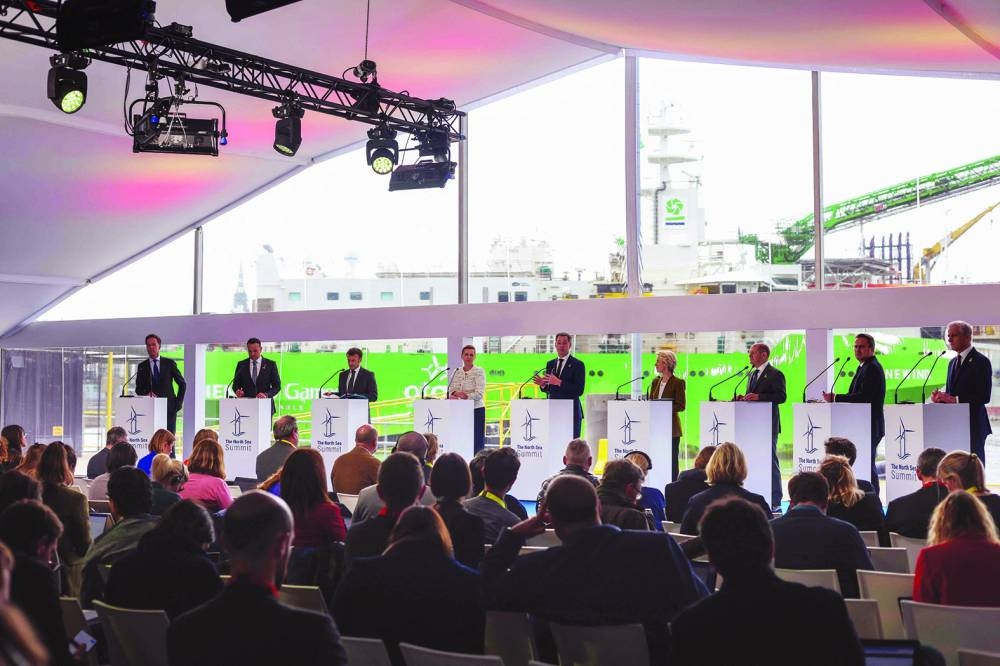Leaders from European countries surrounding the North Sea pledged yesterday to rapidly scale up offshore wind power generation in the region to strengthen energy security, at a summit in Ostend, Belgium.
Leaders from seven European Union countries, including France, Germany and the Netherlands, alongside non-EU countries Norway and Britain pledged to speed up their buildout of wind farms, develop “energy islands” – or connected renewable generation sites at sea – and work on carbon capture and renewable hydrogen projects in the region.
“Because of Russia’s brutal war on Ukraine, it has made it absolutely clear that we need to produce more energy ourselves,” said Danish Prime Minister Mette Frederiksen, who added that the massive expansion of renewable energy was crucial to fight climate change.
In a joint statement, the countries’ leaders said they would aim for a combined 120 gigawatts (GW) of offshore wind capacity by 2030 in the North Sea and northern seas including the Irish sea, and 300GW by 2050.
That would more than quadruple the countries’ 25GW of existing North Sea wind capacity.
The European Union has calculated that installing enough offshore wind turbines to reach that capacity in 2050 will cost €800bn ($900bn).
“We will take all relevant and appropriate steps to accelerate regulatory and permitting processes for renewable energy and the related grid infrastructure,” the leaders said.
Belgium, Denmark and Ireland plus Luxembourg, which does not have a coast, also signed the pledge.
The United Kingdom signed the declaration but Prime Minister Rishi Sunak did not attend the summit.
The countries also pledged to work together to protect offshore energy infrastructure against security threats.
Such concerns have heightened since unexplained blasts last September ripped holes in the Nord Stream pipelines linking Russia and Germany.
“This declaration is also a great chance to really get security into the design of all new wind farms and infrastructure,” said the Dutch energy minister, Rob Jetten, who attended the summit alongside energy ministers from the other eight countries.
Some countries announced projects to spur the green energy push.
The Netherlands and Britain said they plan to build Europe’s biggest cross-border electricity link connected to an offshore wind farm.
European companies, however, including Orsted and Equinor, warned that their sector is currently too small to support the infrastructure expansion, and increased policy support and funding would be needed to deliver the targets.
French President Emmanuel Macron said the buildout of offshore wind must be driven by European manufacturers, to avoid the expansion of renewable energy creating new dependencies on foreign imports.
“This is a very important opportunity in terms of sovereignty and resilience,” Macron told a news conference.
The comment was apparently directed at China, which currently dominates the solar panels market and is a leader in supplying wind turbines.
The European Union is seeking to shift away from its reliance on China by fostering its own industries.
German Chancellor Olaf Scholz highlighted the role the EU could play as a regional energy provider.
“The energy transport lines are Europe’s vital arteries,” he said. “We are not only producing energy for ourselves but also for our neighbours.”
Final investment decisions in European offshore wind farms hit a 10-year low in 2022 as developers faced record-high inflation, soaring interest rates and volatile energy markets.
Investment has recovered since, but in future years, investments in Europe’s wind energy supply chains are expected to fall short of green energy goals, Wood Mackenzie analysts said.
The EU and Norway also pledged yesterday to work together to use depleted North Sea gas fields to capture and store carbon dioxide (CO2) from industrial emissions.

(From left) Netherlands’ Prime Minister Mark Rutte, Ireland’s Prime Minister Leo Varadkar, France’s President Emmanuel Macron, Denmark’s Prime Minister Mette Frederiksen, Belgium’s Prime Minister Alexander De Croo, President of the European Commission Ursula von der Leyen, Germany’s Chancellor Olaf Scholz, Luxembourg’s Prime Minister Xavier Bettel, and Norway’s Prime Minister Jonas Gahr at the North Sea summit in Ostend.
